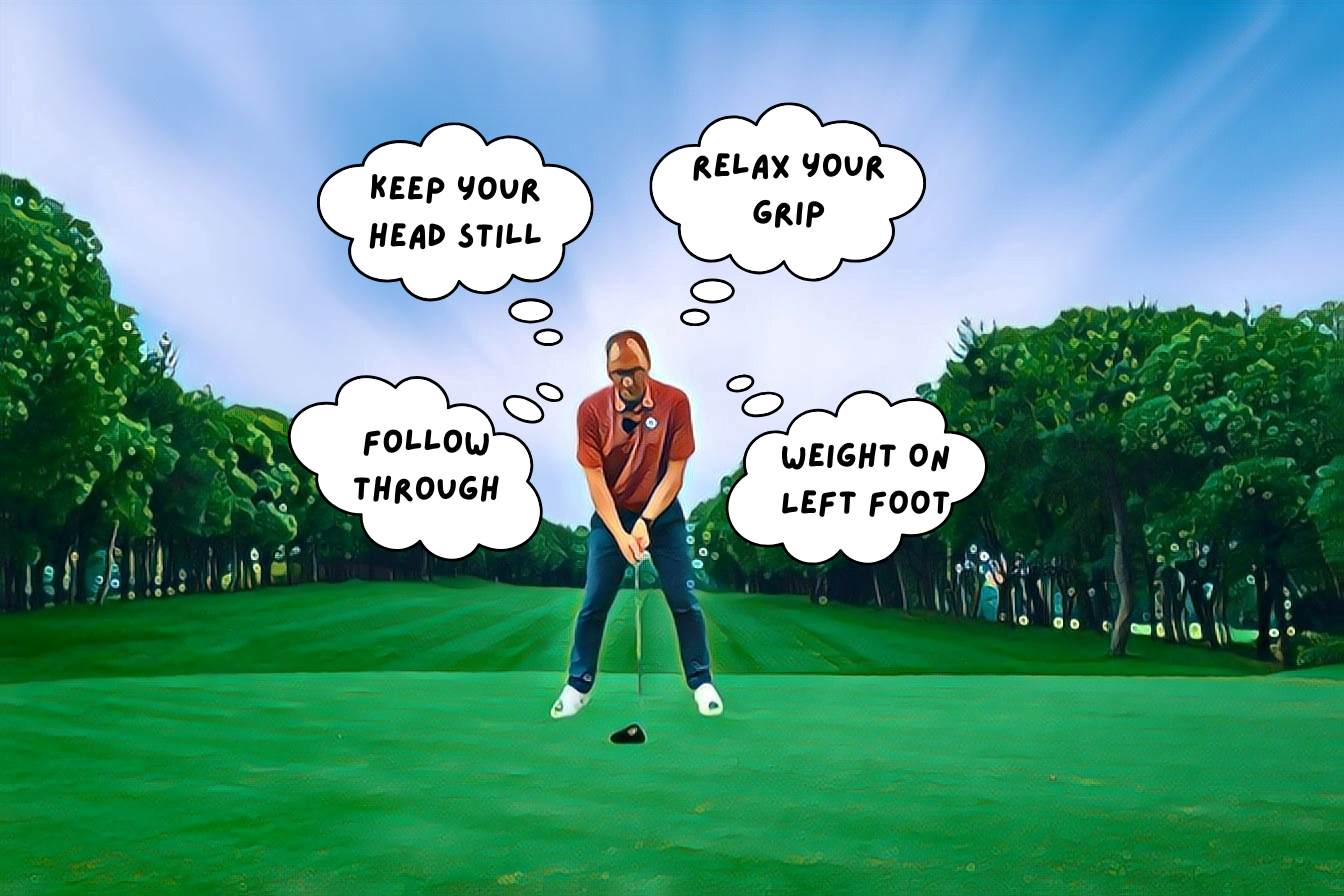
Understanding swing thoughts and their importance in golf can make a significant difference in your performance on the course. In this article, we will explore what swing thoughts are, why they are crucial in golf, common swing thoughts to help enhance your game, and how they impact your overall performance. We will provide tips on how you can improve your swing thoughts and effectively use them during your rounds.
Contents
What Are Swing Thoughts in Golf?
Swing Thoughts in Golf refer to the mental cues or reminders that golfers use to improve their golf swing and performance on the course.
These thoughts often revolve around key aspects of the swing, such as tempo, rhythm, club positioning, or even visualization techniques. By focusing on these specific mental triggers during a swing, golfers can overcome challenges, maintain consistency, and enhance their overall performance. Through repetition and practice, these mental strategies become ingrained in a player’s routine, allowing them to execute shots with greater precision and confidence. In essence, Swing Thoughts act as a guiding compass, helping golfers navigate through the complexities of their swing, leading to improved technique and results on the course.
Why Are Swing Thoughts Important in Golf?
Swing Thoughts are vital in golf as they help golfers maintain focus, improve consistency, and manage pressure situations effectively during gameplay.
Many top PGA Tour players rely on specific Swing Thoughts to stay mentally sharp on the course. For example, Tiger Woods famously focuses on his rhythm and tempo, while Rory McIlroy concentrates on his breathing to control nerves. These personalised mantras not only serve as reminders of proper technique but also act as anchors for the mind amidst distractions. By honing in on these mental cues, players can enhance their overall performance and respond resiliently to the fluid challenges of competitive golf.
What Are Common Swing Thoughts in Golf?
Common Swing Thoughts in Golf include keeping your head still, relaxing your grip, focusing on the follow-through, visualising your shot, and staying present in the moment.
Keeping your head still is crucial as it helps maintain alignment and balance throughout the swing. A relaxed grip reduces tension, allowing for a smoother, more fluid motion. Focusing on the follow-through ensures that you complete the entire motion, leading to more power and accuracy in your shot.
Visualising your shot before you execute it can help in mentally preparing and improving your alignment. Staying present in the moment helps block out distractions, enabling you to focus entirely on the task at hand, much like how pro players such as Justin Thomas and Bryson DeChambeau approach their swings with precision and dedication.
Keep Your Head Still
Keeping your head still during the swing is a fundamental swing thought that promotes better balance, consistency, and accuracy in your shots.
By maintaining a stable head position, you create a solid foundation for your swing, enabling a smoother transfer of weight through the shot. This stability not only enhances your shot precision but also plays a crucial role in ensuring proper body alignment and posture throughout the swing.
When your head remains steady, it helps minimise excessive movement in other parts of your body, leading to more controlled and efficient swing mechanics. This reduction in unnecessary motion allows you to deliver the club to the ball with greater control and power, resulting in more consistent and accurate shots.
Relax Your Grip
Relaxing your grip on the club is a common swing thought that helps golfers generate more clubhead speed, reduce tension, and achieve a smoother swing motion.
Grip pressure in golf plays a pivotal role in the quality of your shots. PGA Professionals often emphasize the importance of maintaining a balanced grip pressure throughout the swing. A relaxed grip not only enhances your swing fluidity but also allows for better wrist action, leading to more consistent and controlled shots.
By loosening your grip, you enable the clubhead to release naturally through impact, promoting a more efficient transfer of energy from the club to the ball. This increased speed and power result in greater shot distance and improved overall performance on the course.
Follow Through
Focusing on a complete follow-through after impact is a crucial swing thought that enhances power transfer, shot direction, and overall swing control.
By executing a full follow-through, a golfer ensures that the clubhead accelerates through the impact zone, maximising clubhead speed and generating more distance on their shots. This extension of the swing also plays a significant role in optimising ball contact by promoting a consistent strike on the sweet spot of the clubface, resulting in cleaner ball flight and improved accuracy.
Experts like Dr. Gabrielle Wulf emphasize that a proper follow-through not only influences the technical aspects of the swing but also shapes the mental side of the game. It instills a sense of commitment to the shot and encourages a smooth, fluid motion that can translate into more reliable and precise shots.
Visualise Your Shot
Visualising your shot before execution is a mental swing thought that helps golfers plan their shots, improve focus, and enhance shot-making confidence on the course.
One of the key benefits of pre-shot visualisation in golf is the way it can aid in shot selection. By mentally picturing the intended shot trajectory and outcome, golfers can better strategise their approach to each hole, considering factors such as distance, hazards, and wind direction. This mental imagery process allows players to visualise different shot shapes and landing spots, helping them make more informed decisions on club selection and overall shot strategy.
Stay in the Moment
Staying present and focused on the current shot is a key swing thought that helps golfers maintain composure, manage distractions, and execute shots with confidence.
In the high-pressure environment of a golf course, where every stroke counts and fluctuating conditions can easily sway a player’s focus, mindfulness serves as a powerful tool. By grounding oneself in the present moment, golfers can make better decisions, assess the situation accurately, and adapt to unforeseen challenges effectively. This ability to stay in the moment not only enhances shot quality but also boosts mental fortitude, enabling players to bounce back from setbacks and maintain a positive mindset throughout the round.
How Do Swing Thoughts Affect Performance?

Swing Thoughts can significantly impact a golfer’s performance by influencing their mental state, shot execution, and overall consistency on the course.
When a golfer maintains positive and focused swing thoughts, they are more likely to execute the shot with precision and confidence. By using mental cues like visualisation or a specific swing key, players can enhance their decision-making process and stay in the present moment. Managing swing thoughts effectively can lead to improved game management, as it helps players stay calm under pressure and navigate challenging situations with clarity.
Positive vs. Negative Thoughts
Distinguishing between positive and negative Swing Thoughts is crucial, as positive thoughts enhance confidence, while negative thoughts can lead to doubt and poor performance.
Positive Swing Thoughts focus on constructive cues such as smooth tempo, confident posture, and visualising successful shots. These thoughts help golfers maintain mental resilience under pressure, leading to consistent and accurate swings.
In contrast, negative Swing Thoughts dwell on errors, feared outcomes, and self-doubt, which can hinder performance. When a golfer shifts from negative to positive thoughts, there is a notable improvement in shot quality, decision-making, and overall game enjoyment.
The Power of Visualization
The practice of visualisation in golf can have a profound impact on performance, as it enables golfers to mentally rehearse shots, enhance focus, and build confidence.
Visualising the perfect swing or the ideal putt allows golfers to ingrain the correct movements in their mind, improving muscle memory and coordination.
Moreover, visualisation aids in decision-making on the course, helping players strategise their shots and adapt to different situations with clarity.
By working with sports psychologists, golfers can learn to harness the power of their minds to achieve peak performance, unlocking their full potential on the green.
How Can You Improve Your Swing Thoughts?

Improving your Swing Thoughts involves practising mindfulness, focusing on one thought at a time, using positive affirmations, and seeking professional guidance for mental conditioning.
When approaching each swing, it’s vital to clear your mind of distractions and doubts, honing in on visualising the perfect shot with unwavering focus. Engaging in mindfulness exercises before hitting the course can help you stay present and calm amid pressure. Incorporating breathing techniques into your routine can aid in relaxation as you approach each shot methodically. Developing a repertoire of effective self-talk phrases can boost confidence and combat negative thinking patterns that can hinder your performance on the course.
Practice Mindfulness
Incorporating mindfulness practices into your golf routine can help you stay present, manage stress, and enhance focus during shots, leading to improved performance on the course.
One powerful mindfulness technique that can significantly impact your game is visualisation. By focusing on your breath, you can calm your mind and body, reducing tension and anxiety. This helps you approach each shot with a clear and focused mindset, which is crucial for making accurate decisions on the course.
Moreover, visualisation plays a key role in enhancing shot concentration. By visualising successful shots before you take them, you are priming your brain and body to execute the desired outcome. This mental rehearsal can increase your confidence and boost the likelihood of achieving your desired results.
Another vital aspect of mindfulness in golf is practising present moment awareness. Staying fully engaged in the present moment allows you to let go of past mistakes and future worries, enabling you to focus on the task at hand. This kind of mindfulness enhances your game composure, helping you perform under pressure and maintain a positive attitude throughout your round.
Focus on One Thought at a Time
Narrowing your focus to one specific Swing Thought at a time can help simplify your mental approach, increase consistency, and reduce overthinking on the course.
By honing in on a single aspect of your swing mechanics, you can declutter your mind from distractions and doubts that often creep in during a round. This singular thought focus allows you to channel your energy and concentration towards a specific goal, enhancing your ability to execute each shot with precision and confidence. Eliminating the burden of analysing multiple swing components simultaneously can lead to smoother, more fluid movements and more controlled ball striking.
With a clear Swing Thought guiding your actions, decision-making becomes more intuitive and decisive. You can trust your instincts and muscle memory to take over, freeing yourself from hesitation and second-guessing. This streamlined process not only improves your shot-making but also cultivates a sense of mental clarity and composure under pressure, essential for navigating challenging course conditions.
Use Positive Affirmations
Employing positive affirmations can boost confidence, reinforce good habits, and instil a winning mindset that enhances performance and resilience in challenging situations.
When golfers consistently engage in positive self-talk, they create a powerful internal dialogue that cultivates belief in their abilities and drives a sense of give the power toment on the course. This proactive approach to mental conditioning is like planting seeds of success that grow and blossom with each swing of the club. By replacing doubt and negative thoughts with uplifting affirmations, golfers can transform their emotional state, leading to a more focused and composed demeanour during critical shots. The impact goes beyond just the mental realm, as positive self-talk has been shown to influence physical performance, enabling players to execute shots with greater precision and confidence.
Seek Professional Help
Consulting with mental coaches, sports psychologists, or PGA Professionals can provide specialised guidance to refine your Swing Thoughts, mental strategies, and overall performance in golf.
These professionals have the expertise to analyse your mental game, identify weaknesses, and work with you to overcome mental hurdles that may be holding back your performance on the course. By tailoring strategies to suit your individual needs, they can help you develop customised mental training plans that address areas of improvement and enhance your mental resilience.
This targeted approach can lead to significant improvements in your game, enabling you to navigate pressure situations with greater ease, maintain focus throughout the round, and ultimately achieve more consistent and successful results in your golf game.
What Are Some Tips for Using Swing Thoughts on the Course?

When using Swing Thoughts on the course, focus on simplicity, consistency, adaptability, and patience to integrate mental cues effectively into your game and elevate your performance.
Paul Casey exemplifies the power of clear Swing Thoughts by honing in on a singular focus before each shot. For him, it might be a simple reminder to keep his head still or maintain a smooth tempo. This unwavering clarity allows him to execute his shots with precision and confidence.
Similarly, Collin Morikawa showcases the importance of routine reinforcement by incorporating consistent mental cues into his pre-shot routine. By consistently visualising his desired outcome, he reinforces positive swing habits and sets himself up for success on every shot.
Frequently Asked Questions
What are swing thoughts in golf?
Swing thoughts are mental cues or reminders that golfers use to help improve their swing technique and performance on the course.
How do swing thoughts help improve my golf game?
Swing thoughts can help golfers focus on specific elements of their swing, such as alignment, tempo, or follow through, which can lead to more consistent and accurate shots.
What are some common swing thoughts in golf?
Some popular swing thoughts include keeping your head down, maintaining a smooth tempo, and visualising a specific shot or swing path.
Should I have multiple swing thoughts or just one?
Every golfer is different, but it’s generally recommended to focus on one or two key swing thoughts during a round to avoid overthinking and becoming too distracted.
Can swing thoughts be detrimental to my golf game?
While swing thoughts can be helpful, they can also become overwhelming or distracting if there are too many or if they are not personalised to your specific swing. It’s important to find the right balance and not rely too heavily on swing thoughts.
How can I come up with my own swing thoughts?
The best swing thoughts are personalised to each golfer’s individual swing and can come from observations made during practice or from tips given by a golf coach or instructor. Experiment with different thoughts and see what works best for you.

